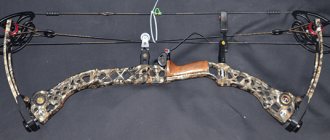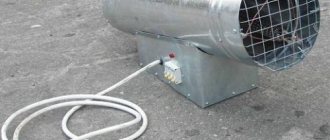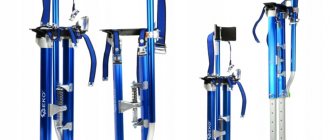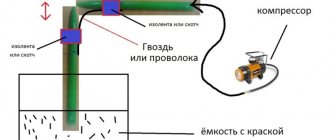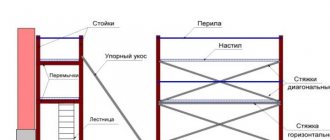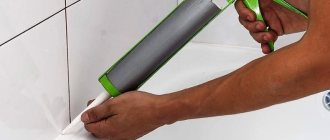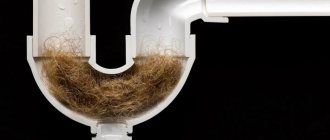Simple plumb line: device
The principle of its operation is simply simple. The load provides the necessary gravity; during operation, the lace is tensioned, accurately determining the vertical direction. Established standards are used in production.
What is included with the device? It consists of a head, body, insert, strip and cord. Durable steel is suitable for the body and head; polyamide can be used for the insert. Planks are made from sheets of aluminum grades AD-1 or AD, the thickness of which should be no more than two millimeters (other types of non-ferrous metal can be used).
To ensure more precise work, sharp edges must be dulled. The cord used is chlorine or nylon fibers twisted into a rope. You can replace them with other materials that have adequate strength and reliability. It’s easy to make such a device yourself; you can use suitable materials at hand.
Algorithm for working with marking cord
The design of the device is quite simple, using the marking cord is also easy.
How to refill
In order for the cord to leave a clear and contrasting mark on the marked surface, the body must be filled with high-quality coloring powder. During the unwinding process, the thread is coated with powder and becomes ready for marking.
In order to fill the body with dye, you need to unscrew the cap covering the loading hole. Powder is poured into it.
Its supply inside the case will have to be replenished whenever the marking line, broken off by the cord, begins to fade.
When using for the first time after purchase, you must completely unwind the thread and fill in the pigment to three-quarters of the volume of the body. Next, the thread is wound up and the device is shaken vigorously. You should not save on purchasing a coloring composition. In Moscow, powder of acceptable quality should not cost less than 80-100 rubles
How to thread the marking cord
Performing markup
First, using a hydraulic or laser level, reference points are placed at the beginning and end of the marked line. Screws are screwed into them or small nails are driven into them. The marking thread is stretched between them. Now you need to take the cord by the middle with two fingers, pull it a little in a direction perpendicular to the surface and the marked line and release it. A clear straight line should appear on the surface. Now you can remove the cord from the markers and move on to marking the next line.
If it is possible to attract an assistant, the work will speed up significantly. No need to attach markers. One presses the beginning of the thread, the other the end. One of the workers pulls back and releases the thread.
Marking with marker cord
How to use a marking cord correctly in specific situations?
To mark gypsum suspended ceilings, you must follow the following recommendations:
- Find the lowest point on the rough ceiling, which will be covered with plasterboard. To do this, use a hydraulic level or level. It will be much more convenient and faster to use a laser level. Its high price will pay for itself many times over due to the time saved.
- At the found level, a mark is made on the nearest wall. Using a level, spirit level or laser level, I repeat the mark twice on each wall.
- The beginning and end of the marking cord are recorded using the marks set; it should fit snugly to the surface.
- Take the thread by the middle with two fingers, pull it a little and quickly release it. After impact, the paint powder leaves a smooth mark on the wall.
- The operation is repeated on the remaining walls.
The broken contour will serve as a guide for installing the starting guide profile, to which the suspended ceiling will be attached.
If the room has an imperfect shape, deviating from a regular rectangle, then when laying ceramic tiles on the floor, even rows will emphasize this. In one corner the wedge will be clearly visible. To disguise such a defect, the tiles are laid diagonally.
Marking with marker cord
To apply diagonal markings to the screed under a ceramic tile floor, proceed as follows:
- The marking cord is pulled between the corners of the room at a height of 5-10 mm from the surface of the subfloor and the main diagonal is marked.
- The cord is stretched between the other two corners and the second diagonal is beaten off.
- The intersection point of the two lines will mark the geometric center of the room;
- From it, on both sides along the main diagonal, the first two rows of tiles should be laid out, using centering crosses to maintain equal distance and spacing.
Next, the rows of tiles are laid from the center to the auxiliary corners, using the first two rows as reference ones.
Device and characteristics
The design of a conventional plumb line consists of a weight, which has the shape of a cylinder with a pointed end (visually the object resembles an oblong bullet) and a cord attached to the center of the base of the weight.
Using this device, you can quickly check the verticality of various surfaces or buildings, and, if necessary, mark vertical lines on a wall or other covering.
The price of plumb lines is more than acceptable.
You can buy such a product for an average of 100 rubles.
But it is worth considering that more modern models equipped with additional functions will differ significantly from the declared cost.
Dimensions and weight
Depending on the material used and the manufacturer, the weight of the cylinder and the footage of the cord may vary slightly.
On average, the weight of a simple cord plumb line is 200 - 250 grams, and the length when extended ranges from 5 to 8 meters.
Construction plumb line with cord
A plumb line with a cord is a small metal weight on a long rope. This device comes with an additional fastener for tight fixation on a hard surface. This tool is designed to determine the vertical plane of walls and any buildings.
Thanks to this device, it is possible to make an even vertical or horizontal line in relation to the ceiling. It is often used in the initial stages of construction of a residential building. It ensures even laying of the building material.
The product has a low cost, which makes it accessible to every consumer. You can make such a device yourself using available materials.
The photo of a construction plumb line shows a modern model of the tool.
Some tips
Classic plumb lines do not require much knowledge. It is enough to fix the bar on a vertical surface, lower the cord and wait for it to fix in one position.
Read also: What is a hackathon and why are they needed?
Laser and electric plumb lines have instructions that you should read before starting work.
History[ | ]
The use of a plumb line, it must be assumed, originated in Egypt during the construction of buildings. Plumb lines dating back to the end of the Third Dynasty have been found[1]. The Egyptians invented a tool resembling the letter E, from which a plumb line was suspended from the upper outer part of the E. Testing the verticality of the surface is achieved by applying a plumb line to it. The position of the surface is vertical if the thread touches the lower protrusion of the plumb line, while remaining level. Oddly enough, this useful tool appears to have been forgotten for many centuries and has only reappeared in modern times.[2]
Electronic type of device
Electronic models are still rarely found in separate form. They can often be found as an attachment to smartphones (such as iPhones) or other electronic devices. But for specialists and craftsmen this is a good helper. The name of one such application, translated into Russian, means nothing more than “a carpenter with hands.” It will not replace a real tool, but it will help with some work. With it you can always check the evenness of the walls when finishing, or check how a pillar or rack stands. This device does not take up much space and is always at hand.
But it’s not at all difficult to understand how to correctly use a plumb line when laying, especially since gadgets have long been helping us in many matters. There is a virtual weight on a cord on the screen; it points with a shadow at the coordinates of the virtual system. To make the readings more accurate, there is a special “top view” diagram in the right corner, and there a red dot marks the deviation from the vertical axis. The deviation can be seen in degrees, both horizontally and vertically, that is, along the X- and Y-planes. Using the control buttons, you can fix all the indicators, and after the work done, return them to their original position.
Often there is a bubble instead of a weight; it also shows the level of deflection of a wall or other surface.
Where is it used?
A plumb line is an indispensable thing during construction. The scope of application of the device is very wide. It is needed for the following construction processes:
- control of surface evenness;
- installation of a plaster beacon;
- drawing vertical lines;
- installation of door and window openings;
- installation of roof rafters;
- placement of formwork.
If there is a need to adjust vertical surfaces, then it is necessary to use a plumb line. It should be noted that excavation work is accompanied by the use of a plumb line. This device helps determine the evenness of the walls of trenches and pits. Masons also use a plumb line when performing their work.
If you are engaged in repairs and plan to hang wallpaper, it is the cord plumb line that will ensure even and high-quality gluing of the material.
Cone, laser and paint models
For finishing work, specialists use a special painting option. With its help, you can well level the surface of the wall with cement mortar or putty. A device of this type is intended for monitoring vertical surfaces and for marking. This tool is convenient because its tip can always slide inward, which means that injuries will be reduced during operation.
This property also helps protect the instrument from damage during falls. This tool is made from a braided cord, which means it will reduce the rotation of the tip during operation. Often, such models are sold with special elastic linings that help protect the surface from mechanical damage.
The laser plumb line has not been around for long; it is usually used when the most precise leveling of the surface is required. Its advantage is that it is completely waterproof and can also easily rotate 360 degrees around its axis, so it is able to produce very accurate results. It communicates two guide lines at once.
The conical type of such a tool belongs to ordinary construction ones. With its help, you can always check vertical lines during any construction work, including painting. Its advantage is that it is made of durable alloy steel, and also with a special galvanized coating.
Kinds
The modern market is overflowing with various types of construction plumbs. You can choose exactly the one that is suitable for a certain type of work. Such instruments are divided into the following types.
- Classic. The constituent elements of this type of plumb line are a metal boning and a cord. A representative of this class is a magnetic plumb line. It is characterized by the presence of a built-in magnet. This feature makes it possible to attach the device to a metal surface. The device can also be used when working with wooden surfaces - there is a special needle that is used as a fastening element.
- Laser. This plumb line is often used in the construction process. The device is characterized by its small dimensions and the ability to operate on both battery and battery power. When turned on, the device directs laser beams to the desired surface. To determine the discrepancies, you just need to look at the screen where all the indicators are visible. Today this device is very popular. This is due to ease of use and functionality.
There are models of laser plumb line that record and display not only vertical indicators, but also horizontal ones and even angular deviations. Of course, they are more expensive than standard ones.
- Electronic. This is not the name of a device, but an application for a mobile phone. Its installation is possible if the phone is based on Android OS. This application is becoming more and more popular every day, because it is very convenient to use - it is always at hand. All you need to do is install the gadget on the surface under study. The application will independently determine all deviations and show them on the smartphone display.
I would also like to highlight homemade plumb lines with a cord, which are the simplest design. The structural components are, for example, a heavy nut or bolt and a thread of the length you need. Such a device can be made independently if necessary.
Types of plumb lines and their purpose
A construction plumb line is an indispensable tool when performing almost any type of installation work.
In addition to the usual cord plumb, products are divided into the following types:
Classic plumb
It consists of a metal blank and a cord; one of the varieties of such a plumb line is a magnetic plumb line.
The magnetic version is distinguished by the fact that it has a built-in magnet, thanks to which the tool can be attached to any metal surface.
Laser plumb line
This product has small dimensions; the design of the item may vary depending on the manufacturer.
The device can be powered by a removable battery or simple batteries.
When you turn on the device, the system independently projects laser dots onto the walls, floor and ceiling.
Determining level discrepancies is not difficult, since usually all indicators are displayed on a small plumb screen.
If it is absent, special lines are displayed on the measured surfaces; their distortion indicates the presence of inconsistencies.
This type of device is easy to use.
In addition, modern models combine several functions at the same time - optical systems measure verticals, horizontals and angular divergence.
An alternative to such a plumb line is a regular laser pointer.
Electronic plumb line
It is a special application that is installed on a smartphone based on the Android system.
It is very convenient to use such a program.
When the phone is placed on the surface under study, indicators of the deflection angles and their direction are displayed on the display.
Homemade plumb line
This product has the most simplified design.
It looks like an ordinary nut or any other object, to the end of which a strong thread/rope is tied.
How to make a plumb line with your own hands
The key is to find or make a weight that is well centered. Then you need a short bolt of decent diameter (now you’ll understand why). Exactly in the middle of the bolt - through the head, along the rod - drill a hole.
Now a hole is drilled in the body of the load to the size of the bolt and the corresponding thread is cut. A thin, strong cord is threaded into the bolt from the side of the cap. At the exit of the bolt, it is tied into a knot so that it does not jump out. The bolt with the cord is screwed into the prepared hole. That's it, your construction plumb line is made with your own hands.
The second option for attaching the thread is this: make a through hole exactly in the middle of the weight and pass the cord through it, only the loop needs to be made long, and the diameter of the hole should be much larger than the diameter of the cord. All this together will allow the load to take a strictly vertical position.
Precise homemade plumb line from plywood scraps
A homemade plumb line will allow you to quickly and, most importantly, accurately adjust the vertical position of walls, partitions, pillars, columns and other surfaces. You can make such a plumb line from ordinary scraps of plywood, and it will take no more than 10–15 minutes.
First of all, you need to glue the plywood scraps together so that you get a block approximately 30–40 mm thick. If you don’t have plywood on hand, you can use wooden blocks (for example, a 50x50 mm block will do).
To make an accurate plumb line, you will need three pieces in total: one long block (about 100 cm long) and two “short ones”. The block itself should preferably be at least 10 cm wide.
Making a homemade plumb line
After all three blanks are cut exactly to size, we proceed to making a plumb line - to do this, we first glue the parts together. On the wide side of the long bar, you need to glue two “short ones” at a distance of at least 50 cm.
Next, mark the center of the top short block and drill a through hole in it diagonally, into which we thread a nylon thread (or lace) and tie its end into a knot. At the other end of the rope we attach a heavy weight - for example, a large nut.
This is how you can quickly and easily make an accurate plumb line with your own hands from scraps of plywood. For a detailed process of making this homemade product, watch the video on the website. Write in the comments what you think about this plumb line.
Construction plumb line with cord - how to use?
Using a plumb line, check the degree of verticality of sides, walls and surfaces. To carry out measurements, it must be fixed at the highest point of the object or plane being measured.
Some model variants are equipped with a washer whose diameter is equal to that of the cylinder. There is a washer at one end of the device and a weight at the other.
By applying a washer to the plane and waiting until the weight stops oscillating, you can see the difference between the plane being tested and the vertical thread.
The shadow of the thread is also located vertically, so you can also navigate by it.
Some models are not equipped with a washer; in them, the cord is simply wound on a special piece of plastic, on which markings can be applied.
There are tools in which the cord is hidden in a plastic case, like a tape measure. The body in them can be used as a support for the cord.
For some types of work (for example, when plastering), the plumb line should be in front of your eyes at all times - this makes it more convenient to level the surface.
In such cases, a special fastener is arranged for it, the role of which can be played by a hammered nail or self-tapping screw. A cord is attached to it, and the weight is lowered down in an ideal vertical. Having this standard in front of your eyes, you can constantly monitor the evenness of the surface.
This is how they check the evenness and verticality of the walls, the correct assembly of furniture and the installation of household appliances. When bricklaying work is carried out, a plumb line is necessary to check the wall to see if it has fallen off. It is applied alternately on both sides, checking the entire distance from the surface to the cord. It must be strictly the same. Control must be carried out at several different points.
The quality of construction (verticality) of walls made of timber and logs is controlled in a similar way. However, in cases of using non-rounded logs, the control process is complicated by the difference in the size of the crowns. But you can notice a deviation in such a situation.
You cannot do without a plumb line when installing formwork, rafter systems, or installing doors.
Almost all construction operations cannot be carried out without the control of this simple device.
But even such a simple device has one significant drawback. After all, construction work is often carried out outdoors. If there is wind outside, it makes working with the plumb line extremely difficult: the weight swings, which makes it very difficult to fix it. But the solution to this problem turned out to be quite simple - the weight is immersed in a pre-prepared container with water. If the wind is not very strong, then it is quite possible to work in it.
Construction plumb line magnetic
Additional fuss with the cord cannot please installers and builders. In addition, it often gets tangled and knots appear on it that have to be untangled.
To get rid of these shortcomings, an improved type of device was developed. Its thread is wound onto a spool in the housing.
For convenient mounting on the work surface, special magnets are built into its body. They provide easy fixation of the tool on any metal surface.
Using a magnet, it can be attached at any height. For working with wood, there is a special needle built into the body.
Laser plumb line
The simplest representative of this type is an ordinary laser pointer. There was this type of tiny keychain that kids loved to play around with. Only this device, unlike a children's toy, must be calibrated. There are very few laser devices on the market that perform exclusively the function of a plumb line.
Eubon-PB01-
This is, for example, a simplified model of the Eubon PB01 brand, which is a metal case, on the pin of which the pointer itself is placed.
The device generates two points, on the floor and on the ceiling, and has no additional functions. The device is leveled by itself, using a special design reminiscent of that of a simple cord plumb line.
The operating range of the device is 30 m, while it has fairly high accuracy and is powered by batteries. The price of such a construction plumb line is quite high.
Products manufactured by unknown companies have a lower cost. On trays you can find similar models at a price several times lower than the original. Before using them, you should definitely test them with reliable tools.
Well-known serious manufacturers also produce devices of such models. Their price, naturally, corresponds to the status of their manufacturers. The LED of the device is enclosed in a durable plastic case; it has a special self-leveling system at a certain degree of deviation from the horizontal.
Laser equipment of this type is produced by Bosh, Spectra, DeWOLT and others. The accuracy of their measurements is up to 0.4 mm.
Electronic plumb line
Application screenshot
It is rather not a construction tool, but an application installed on the iPhone, bearing the original name “Handy Carpenter” or iHandy Carpenter.
It is not a professional measuring device, but it is quite capable of assessing the evenness of a particular surface, determining how smoothly the finishing is done or the furniture is installed.
How does the application work? After starting it, the device is applied to the surface that needs to be checked.
There is a coordinate system on its screen, and a weight is also depicted there: the deviation can be seen visually, in addition, the results are displayed at the very top of the monitor. The deviation relative to the conventional system is also displayed, which is expressed in degrees.
A similar program is provided for tablets and smartphones - Plumb-bob. It allows you to measure distances, angles, determine horizontal and vertical lines. You can take a photo by first setting and measuring the necessary parameters, and all the results of the measurements taken will be saved. They will be displayed on the device screen, where they can be carefully examined.
Is it possible to make a construction plumb level yourself?
Suppose you started renovation work in your house, and you didn’t find a plumb line among the tools. What should we do, should we really wind up everything and urgently go to the store to buy a plumb line for work?
Don’t despair if you don’t have the necessary device; anyone can make it with their own hands.
If you need to level any surface, you can use a homemade product made from improvised materials. How to make a painting plumb line with your own hands? You will need a strong, reliable cord about a meter long, to which you need to tie the load. Its role can be played by an ordinary nut, heavy enough for this.
We can assume that the tool is ready and can be used. When taking the necessary measurements, you should hold the twine tightly and make sure that the nut does not unscrew in different directions. If the surface to be leveled has a small area, then instead of a nut you can take a small perfume bottle.
It is important to follow the rule when working with such a tool: it should not come into contact with the surface, at least a small distance should separate them.
If larger-scale work is planned, for example, masonry on a suburban area, then a larger plumb line will be needed. A thick clothesline will replace the cord; even a plastic water bottle will do instead of a weight. But it is more advisable to use heavy parts made of metal.
Laser modifications
The vertical position of the surface under study can be checked with laser plummets. The simplest representative of this category is the pointer. It is made like a keychain with a laser target pointer. There are not so many similar devices focused exclusively on construction work. One of the modifications is a metal body, on the pin of which the pointer is located.
The device generates points on the floor and ceiling. The leveling process occurs automatically using a special mechanism that vaguely resembles an analogue of a cord plumb line. Well-known manufacturers in the construction market offer devices with an operating range of up to 30 meters. They are highly accurate, powered by batteries, and quite expensive.
Inexpensive products from little-known companies and homemade versions are widely offered in the markets. Such an instrument requires control testing using reliable reference instruments. One of the design options is a plastic case with an LED placed inside and a self-leveling system that responds to a certain degree of deviation in the horizontal plane.
Popular plumbs
The most popular and frequently used building levels, according to specialist builders, are products from the following brands.
- Matrix. This company guarantees high quality, reliability and a guarantee from the manufacturer. Absolutely all hand tools with a Matrix marker comply with the requirements and standards of construction acts and documents. The brand's plumb line is characterized by high measurement accuracy, compact dimensions and a relatively affordable price.
- "Practitioner". This company is also one of the leaders in the production of construction hand-held measuring tools. Praktik products are in demand among both professionals and amateurs. The brand guarantees the quality and reliability of its products.
It is also worth noting other manufacturers whose products are represented on the modern construction market: GROSS, Unitraum, JTC, Autel, TORTUL, Baum, Sumake.
